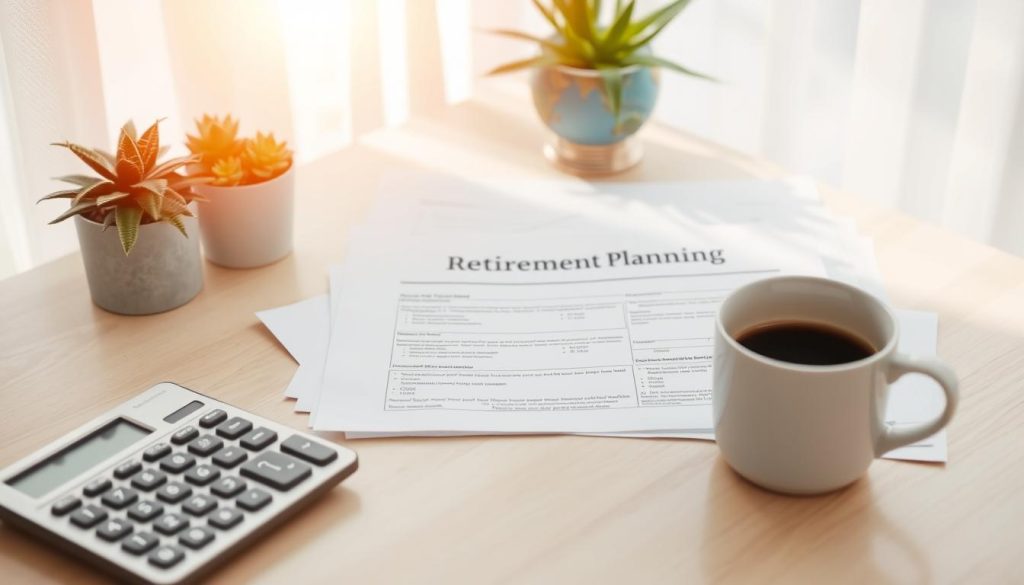Retirement planning is key to a secure financial future. It helps you enjoy your golden years with peace of mind. Let’s look at how to set and reach your retirement goals.
Early preparation is vital. In 2019, 62% of older households had debt, up from 43% in 1992. The median debt rose from £7,294 to £34,000. This shows the need for careful financial planning.
Knowing your future income is important. Yet, over a third of retirees get less from Social Security than they expected. This highlights the need for a broad plan, not just state pensions.
When planning for retirement, think about both money and lifestyle. Over 50% of those nearing retirement want to spend more time with family. And 45% aim to travel more. Include these dreams in your financial plans for a happy retirement.
Key Takeaways
- Start retirement planning early to manage debt and build savings
- Understand your future income sources, including state pensions
- Consider lifestyle goals when planning your finances
- Aim to save 10 times your pre-retirement annual earnings by age 67
- Plan for both financial security and personal fulfilment in retirement
Understanding Your Current Financial Position
Knowing your financial situation is key to planning for retirement. You need to look at your savings, income, and debts. This helps build a strong retirement plan.
Assessing Your Current Savings and Investments
First, check your retirement savings. This includes pensions and investments like stocks. For example, John and Jan have £600,000 saved. It’s important to keep an eye on how these investments are doing.
Evaluating Your Income Sources
Then, think about your income now and in the future. This includes your job, rental income, and State Pension. John and Jan get £12,000 from a rental property and expect £18,000 from their State Pensions at 68.
Analysing Existing Debts and Liabilities
Lastly, look at your debts and ongoing costs. These can affect your retirement plans a lot. It’s vital to have a plan to manage or pay off these debts before you retire.
| Financial Aspect | Current Status | Retirement Goal |
|---|---|---|
| Annual Income | £12,000 (property) | £50,000 |
| Retirement Savings | £600,000 | To be determined |
| State Pension (from age 68) | N/A | £18,000 annually |

Understanding your finances is essential for setting realistic retirement goals. By evaluating your income and savings, you can find any gaps. Remember, this is an ongoing process to keep your retirement plans on track.
Setting Realistic Retirement Goals
Planning for retirement means thinking about your financial needs and what you want to do in your free time. It’s important to set goals that are realistic for a happy retirement. Let’s look at how to make goals that match your retirement dreams.

In the UK, there are many ways to plan for retirement. From age 55 (going up to 57 in 2028), you can start using your pension savings. This gives you time to plan early, but remember, your money might last 20 to 30 years.
When planning your finances, look at the Retirement Living Standards. These standards show income goals for different lifestyles:
- Minimum
- Moderate
- Comfortable
Each level shows how much money you might need each year in retirement. This helps you figure out how much you should save.
“Retirement planning is 50% financial goals and 50% non-financial goals.”
Setting goals should cover both money and what you want to do. Financial goals might include big purchases like a £20,000 kitchen or regular costs like £7,000 a year for travel. Non-financial goals could be about making time for things like the gym, learning a new language, or spending time with family.
| Goal Type | Example | Estimated Cost |
|---|---|---|
| One-off Expense | Kitchen Renovation | £20,000 |
| Recurring Expense | Annual Domestic Travel | £7,000 |
| Lifestyle Goal | Weekly Spanish Lessons | Varies |
Remember, planning for retirement is a journey. Keep checking and changing your goals to fit your life and dreams.
Plan Goals During Retirement
Retirement is a new chapter filled with growth and fun. It’s important to plan your retirement lifestyle well. Let’s look at key areas to consider for your retirement goals.
Lifestyle Requirements and Aspirations
Your retirement lifestyle should match your values and dreams. You might want a quiet life in the countryside or an active city life. It’s wise to plan for 100% of your pre-retirement costs to stay comfortable.

Healthcare Considerations
Healthcare planning is key in retirement. With an average life expectancy of 18 years for a 66-year-old, plan for medical costs. Think about private health insurance to cover more than the NHS.
Travel and Leisure Planning
Retirement means more time for travel and hobbies. These activities can increase your financial needs. Budget for these activities and consider part-time work to fund them.
| Retirement Aspect | Considerations |
|---|---|
| Lifestyle | Plan for 80-100% of current expenses |
| Healthcare | Budget for increased medical costs |
| Leisure | Allocate funds for hobbies and travel |
By thinking about these aspects, you can have a fulfilling and secure retirement. Regularly review your plan to adjust to life’s changes and make your retirement dreams come true.
Calculating Your Retirement Number
Finding out how much you need for retirement is key. This amount helps you keep your lifestyle going when you’re not working. Let’s look at what affects this number.
The 4% Withdrawal Rule
The 4% rule is a common way to plan for retirement. It says you can take out 4% of your savings each year without running out. For example, if you want £40,000 a year, you’ll need £1 million saved (£40,000 / 0.04).
Inflation Considerations
Inflation is a big deal when planning for retirement. Over the last 30 years, inflation has been about 2.6%. So, your savings need to grow to keep up with prices. A £100,000 income today might be worth £134,000 in 10 years.
Life Expectancy Factors
Most people spend 18 to 20 years in retirement. It’s smart to plan for a longer retirement, as people are living longer. This means you might need more money saved.
| Current Age | Retirement Age | Years in Retirement | Estimated Savings Needed |
|---|---|---|---|
| 30 | 67 | 20 | £1,000,000 |
| 40 | 67 | 18 | £900,000 |
| 50 | 67 | 16 | £800,000 |
These numbers are just estimates. Your real retirement needs might be different. It’s important to check and update your plan often to stay financially secure in your later years.

Building Your Emergency Fund Strategy
Having a strong financial buffer is key for a secure retirement. It protects you from sudden costs and income drops. This keeps your long-term financial plans safe.

Recent studies show a worrying trend: 60% of Americans can’t cover a £1,000 emergency. This highlights the need for a solid emergency fund before retirement.
Experts say you should save three to six months’ worth of expenses. For retirees, it might be more, like seven years in short-term bonds.
To grow your emergency fund:
- Start small: Set up automatic transfers of £50 to £100 monthly
- Leverage windfalls: Allocate 50% of unexpected income to your fund
- Choose high-yield savings accounts for better growth
- Review and adjust annually to keep pace with inflation
Remember, your emergency fund needs may change in retirement. Think about fixed income, healthcare costs, and climate risks in your area. This will help you decide how big your fund should be.
| Income Stability | Recommended Emergency Fund |
|---|---|
| Stable fixed income | 3-4 months of expenses |
| Variable income | 6-7 months of expenses |
| Self-employed/Gig economy | 9-12 months of expenses |
By focusing on your emergency savings, you’ll build a financial safety net. This will protect your retirement dreams from life’s surprises.
Managing and Reducing Debt Before Retirement
Dealing with debt is key for a happy retirement. In the UK, 63% of households over 65 have some debt. This is up from 38% in the late 1980s. It shows how vital good debt management is.
Prioritising Debt Repayment
Start by paying off debts with high interest rates. Credit cards and personal loans usually have higher rates than other debts. For example, those aged 50-64 in the US have an average credit card debt of £5,600. Quick repayment can save a lot on interest.
Debt Consolidation Options
Debt consolidation can make payments easier and might lower interest rates. Look into balance transfer credit cards or personal loans for this. It can help you manage your debt better and get closer to financial freedom.
| Debt Type | Average Balance (Age 50-64) | Interest Rate |
|---|---|---|
| Credit Card | £5,600 | 21% |
| Auto Loan | £17,000 | 4% |
| Mortgage | £153,000 | 3% |
Creating a Debt-Free Timeline
Make realistic plans to be debt-free before you retire. Working two more years and paying off £19,500 in debt can save about £8,500 in interest. This could give you a £9,300 annual spending cushion in retirement. Plan your debt repayment and retirement savings together to reach your goals.

Getting professional advice can help with debt management and retirement planning. With the right plan, you can aim for a debt-free retirement and lasting financial freedom.
Optimising Your Investment Portfolio
As retirement gets closer, it’s vital to refine your investment plan. A good portfolio balances growth with safety, making sure your money works for you. Let’s look at how to make your investments secure for the future.

Diversifying your portfolio is key to reducing risk. By investing in different types of assets, you can shield your money from market ups and downs. Planning for retirement goals with confidence often means mixing stocks, bonds, and other investments.
As you get closer to retirement, think about your risk level. You might want to move to safer options, but don’t forget about growth. A balanced strategy can protect your wealth while allowing it to grow.
“A diversified portfolio can be 30% less volatile than a non-diversified one.”
Regularly rebalancing your portfolio is critical. This means adjusting your investments to keep your risk level right. As markets change, some investments might grow more than others, throwing off your balance.
| Asset Class | Conservative Allocation | Moderate Allocation | Aggressive Allocation |
|---|---|---|---|
| Stocks | 30% | 50% | 70% |
| Bonds | 50% | 30% | 20% |
| Cash | 15% | 10% | 5% |
| Alternatives | 5% | 10% | 5% |
Your investment strategy should change as you near retirement. Keep up with market news and consider getting expert advice. This will help make sure your portfolio meets your retirement goals.
Understanding Pension Options
Pension planning is key to a secure retirement. The UK has many pension options, each with its own benefits. Let’s look at the main types of pensions and how they help secure your future.
State Pension Benefits
The State Pension is a main source of income for many in the UK. It’s paid every four weeks when you reach State Pension age. Not everyone gets the full amount, so it’s important to check what you’re due.
You can ask for a State Pension statement from the government. This will show you what you might get in retirement.
Workplace Pension Schemes
Most workers are automatically signed up for workplace pensions unless they choose not to be. These schemes have big benefits:
- Employers must contribute at least 3% of your earnings
- The total contribution is 8%, including what you put in
- You get tax relief on your contributions, up to 45% for top taxpayers

Private Pension Considerations
Private pensions give you more control over your retirement planning. You can choose from:
- Stakeholder pensions: Low minimum contributions and capped charges
- Self-Invested Personal Pensions (SIPPs): You can invest in property and stocks
- Personal pensions: They’re tailored to your needs
The annual limit for pension contributions is £60,000, but this can change based on your income. You can take 25% of your pension as a tax-free lump sum at retirement. Adding to your contributions regularly can greatly increase your pension.
Creating Sustainable Income Streams
To have a stable retirement, you need different income sources. Just relying on pensions might not be enough. So, investing in other areas is key for a good lifestyle.
Dividend-paying stocks are great for retirees because they offer regular income and can grow. The 4% Rule is a good guide. It says you should only take out 4% of your savings each year, adjusted for inflation, to keep your money safe.

ISAs are tax-efficient, letting you earn tax-free on interest, dividends, and capital gains. SIPPs offer tax relief on contributions. This means you can get more from your money when you withdraw it, up to a certain amount.
The bucket strategy is useful. It puts money for short-term needs in cash or similar, and for long-term goals in income-generating assets. A mix of stocks, bonds, and rental properties can help. It reduces risks and meets both short-term and long-term financial needs.
| Income Stream | Benefits | Considerations |
|---|---|---|
| Dividend Stocks | Regular income, growth | Market volatility |
| Bonds | Predictable interest | Lower growth |
| Rental Properties | Steady income, appreciation | High initial investment, management |
| ISAs | Tax-free earnings | Annual contribution limits |
It’s important to regularly check and adjust your investment plan. This ensures it stays right for your changing financial situation and the market. This way, you keep a strong passive income strategy. It supports your retirement income and financial stability in the long run.
Tax-Efficient Retirement Planning
Smart tax planning can greatly improve your retirement finances. The right strategies help you keep more money. This way, you can enjoy a comfortable retirement.
Maximising Tax Allowances
Pensions offer great tax benefits. You can take up to 25% of your pension tax-free, up to £268,275. Basic-rate taxpayers can earn £1,000 tax-free on savings interest each year. Higher-rate taxpayers get £500.
The capital gains tax exemption allows you to make £3,000 of tax-free gains in 2024/25.

Strategic Withdrawal Planning
Let’s look at Robert and Olivia’s situation. They have £2 million in savings, aiming to withdraw £60,000 each year. They use their personal allowances of £12,570 each and their pensions to withdraw £60,000 tax-free.
This saves them about £8,700 in taxes each year. It’s more than relying only on pensions.
Estate Planning Considerations
Estate planning is key for passing on wealth efficiently. ISAs offer tax-free growth and withdrawals, making them great for inheritance planning. Remember, 75% of pension value is taxed as income when accessed.
By balancing withdrawals between ISAs and pensions, you can keep your total income below the higher-rate tax band. This starts at £50,270.
By using these retirement tax strategies and estate planning, you can greatly improve your financial security in retirement. Always get advice from a financial adviser for tailored tax planning.
Healthcare Planning for Retirement
Planning for retirement healthcare is key, as medical costs can eat into your savings. With retirement lasting 30-40 years, it’s vital to account for healthcare costs rising.

A healthy 65-year-old couple retiring in 2023 might spend nearly 70% of their lifetime Social Security benefits on healthcare. This highlights the need for early planning for retirement healthcare needs.
Long-term care is also a big concern. Almost 70% of people turning 65 will need some form of long-term care. The cost for a private room in a nursing home can be over £100,000 a year, making it a big expense to plan for.
To handle these costs, consider these strategies:
- Start saving early for medical expenses
- Investigate private health insurance options
- Look into long-term care insurance before age 70
- Maintain a healthy lifestyle to potentially reduce healthcare costs
Remember, healthcare costs are going up by 1.5 to 2 times the rate of inflation after the pandemic. By including these costs in your retirement budget and looking at different insurance options, you can prepare for a secure retirement.
Property and Housing Decisions
As you get closer to retirement, making wise property choices is key. Your home is probably your biggest asset. It can make up a big part of your wealth, with studies showing it’s worth 45% to 75% of your net worth.
Let’s look at some important things to think about when it comes to retirement housing.
Downsizing Considerations
Downsizing is a good idea for many retirees. It can help you save money and free up capital. A study by the Center for Retirement Research at Boston College found that housing costs 30% of a retired couple’s budget.
By moving to a smaller place, you can cut these costs a lot.
Equity Release Options
Equity release is another option if you want to stay in your home. It lets you use the value of your property while you live there. For many retirees, their home’s value is more than their investments.

Property Investment Strategies
Some retirees might think about investing in property to earn more money. But, it’s important to think about the stability you might prefer. A study by Richard Green and Hyojung Lee found that people tend to move less after 50.
Many retirees like to stay in one place because of strong community ties and emotional attachments to their homes.
Remember, these decisions are very personal. They should match your financial goals and what you want in your retirement.
Regular Review and Adjustment Strategies
A strong retirement plan review is key to keeping your finances stable in retirement. Regular checks help you keep up with your retirement plan and make any needed changes.

Retirement planning is an ongoing task. It needs constant attention and adjustments. Here’s why regular reviews are so important:
- Life changes can affect your retirement goals
- Market ups and downs can change your investments
- New tax laws can alter your strategy
- Your personal goals might change over time
Experts say you should review your retirement plan every year. This lets you quickly adapt to changes in your finances or the market.
Regular reviews help spot any plan changes, so you can adjust on time.
When you review your retirement plan, think about these things:
| Aspect | Action |
|---|---|
| Income sources | Check your state pension, workplace pensions, and savings |
| Expenses | Update your budget for both essential and fun spending |
| Investments | Look at how they’re doing and rebalance if needed |
| Risk tolerance | Change your investment plan to match your comfort level |
By using these regular review and adjustment strategies, you can keep your retirement plan strong. It will stay in line with your changing needs and goals.
Seeking Professional Financial Advice
Planning for retirement can be complex and daunting. Many Britons find themselves unsure about their financial future. This uncertainty highlights the value of seeking professional advice for retirement planning.
When to Consult an Adviser
It’s wise to seek retirement planning help early. Studies show that an early start provides more options and reduces pressure later. Consider consulting a financial adviser when:
- You’re unsure about your long-term financial goals
- You want to optimise your investment performance
- You need help creating a structured retirement income strategy
Choosing the Right Financial Expert
When selecting a financial adviser, look for qualifications and expertise in retirement planning. A good adviser should:
- Have relevant certifications
- Specialise in retirement planning
- Offer tailored strategies based on individual goals

Understanding Advisory Services
Financial advisers offer various services, from one-off consultations to ongoing relationships. They can help enhance your retirement income replacement by over 15 percentage points. Professional advice often leads to better outcomes, with clients experiencing an average 20% increase in investment performance after working with an adviser for a year.
Remember, seeking professional help is a sign of financial responsibility. With 70% of respondents stating that having a financial adviser adds trust and peace of mind to their retirement planning process, it’s clear that expert guidance can make a significant difference in achieving your retirement goals.
Risk Management in Retirement
Retirement brings new challenges to financial security. It’s key to understand and manage these risks for a stable future. Let’s look at important strategies for managing risks in your golden years.

Market volatility can greatly affect your retirement savings. For example, retirees do better in bull markets than in downturns. To safeguard your savings, spread your investments across different types. This can lead to a 3-5% increase in average annual returns.
Longevity risk is another big worry. With 1 in 4 65-year-olds living past 90, your retirement plan must be long-term. The 4% rule suggests taking 4% of your savings in the first year, then adjusting for inflation.
Healthcare costs are a major risk to financial stability. Long-term care insurance can be helpful, given the average cost of £5,700 per month for a semi-private room. Health Savings Accounts (HSAs) offer tax benefits for medical expenses, with 2023 limits at £2,950 for individuals and £5,900 for families.
| Risk Type | Mitigation Strategy | Potential Benefit |
|---|---|---|
| Market Volatility | Diversification | 3-5% higher annual returns |
| Longevity | 4% Rule | Sustainable income for 30+ years |
| Healthcare Costs | HSAs and Insurance | Tax advantages and cost protection |
Regularly rebalancing your portfolio, ideally every quarter or year, keeps your risk level right. About 70% of those aged 65 and older will need long-term care. This shows how vital it is to plan well for financial security in retirement.
Conclusion
Planning for retirement is key to feeling financially secure and ready for the future. We’ve looked at many ways to plan well for retirement. It starts with knowing where you stand financially and setting clear goals.
It’s good to see that 79% of people focus on retirement planning. But, only 30% have figured out how much they need. Starting to save early can make a big difference, thanks to compound interest.
Remember, planning for retirement is more than just saving money. It’s about making a complete plan. This includes thinking about healthcare costs and long-term care. Also, 88% of retirees feel more at ease with a good plan in place.
Using tools like ISAs and getting professional advice can help. This way, you can make your retirement more secure and enjoyable.

